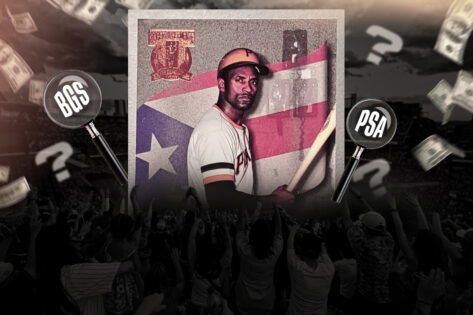Can a small flaw wipe out over a million dollars in value? Believe it or not, it happened with Roberto Clemente’s baseball card. Though Roberto Clemente is no longer with us, his impact as a 15-time All-Star legend lives on, and this time, it was his card making headlines.
Just recently, sports analyst Darren Rovell revealed that two Roberto Clemente baseball cards were sold. Yes, two identical cards but with wildly different prices. One Beckett-graded card sold for $9,000, while the other fetched $1.15 million. The huge difference? Grading.
The $9K card scored a 7. The $1.15M card scored a 9. Just two grades apart, worth over 100x more. In collectibles, condition isn’t just everything; it’s the entire multiplier.
Scarcity at each grade today:
PSA 10 (Gem Mint): Only 1 card exists.
PSA 9 (Mint): Approximately 11 cards.
PSA 8 (Near Mint-Mint): 123 cards.
PSA 7 (Near Mint): 347 cards.
Normally, how does grading work? Why is the value so divergent?
Centering: The quality of centering of the image within the card borders.
Corners: How sharp and how well the corners of the card are.
Edges: If edges are scratched, chipped, or worn.
Surface: Scratches or stains, or blemishes on the front and back of the card.
But who decided these grades?
The companies behind the grades
Grades of sports cards are determined by professionals, such as the Professional Sports Authenticator (PSA) and Beckett Grading Services (BGS), companies. PSA has a basic scale that goes between 1 and 10, with 10 being near perfect. Nine means that the card remains superb, though maybe with a minor flaw such as a slight misalignment or a slight printing mistake.
While Beckett uses the same 1 to 10 scale, but also gives half-points (like 9.5) and grades different parts of the card separately: corners, edges, centering, and surface. This makes their grading more detailed. But their role doesn’t stop there.
Beyond grading, these companies certify both the authenticity and condition of the card, which builds trust for buyers and collectors. On marketplaces like eBay, raw (ungraded) cards often lead to disputes and returns because buyers may feel the card is in worse condition than advertised or even fake. So yes, graded cards, sealed and verified by a trusted third party, reduce these issues.
But why do these cards sometimes reach unrealistically high or low prices?
Rise and fall of graded card prices
When card prices rise too fast, they can become disconnected from the card’s real value. This happens during market bubbles – periods of hype where demand and prices inflate beyond what rarity or premium quality justify. So, what caused the recent bubble in graded cards?
During COVID-19, many people turned to sports card collecting, causing a huge surge in demand. To keep up, PSA tripled its grading capacity since 2018 and added over 120,000 square feet of space by early 2021 to handle the flood of submissions.
Popular cards from large sets like 2018-2020 Panini Prizm and Topps Chrome saw PSA 10 versions skyrocket in price due to investor speculation, not rarity.
And what after that, Bubble?
As grading backlogs cleared and more PSA 10 cards flooded the market, prices began to fall and stabilize.
Buyers shifted focus from short-term hype to long-term value, looking more at player performance and genuine scarcity than just grading alone.
With more experienced collectors, the market matured and speculative bubbles became less common, leading to more realistic pricing.
So, how fast is the sports collectibles market growing?
Understanding today’s sports collectibles market
In 2024, the sports collectibles market was valued at about $38.6 billion globally and is projected to more than double to $91.4 billion by 2032, growing at a strong 14.2% annually. This growth comes from more people loving vintage items, NFTs, and easier buying and selling through online platforms.
Even experts say the best investments are high-quality collectibles connected to famous athletes, especially retired or deceased legends, and that cards graded by trusted companies like PSA or Beckett usually hold or gain value. For example, a mint-condition Mickey Mantle card sold for $12.6 million in 2022, showing the big money in rare, well-kept items. But remember, the market also carries risks.
Key risks:
Card values can change quickly due to player performance, public interest, or economic shifts.
Some collectors went as far as altering graded cards to boost their value. In 2019, the FBI uncovered a scandal involving Gary Moser, who removed cards from their cases, modified them, and resubmitted them for higher grades.
PSA’s backlog hit a very high point in early 2025, causing grading delays up to 65 days and frustrating collectors.
PSA has faced major controversies, including authenticating a tampered 1980 Larry Bird-Magic Johnson rookie card as genuine, damaging or swapping a rare Kobe Bryant card, and misleading collectors about insurance coverage.
In today’s card market, the grade often matters more than the card itself. For instance, a tiny flaw can cost you over a million dollars. Consequently, collectors aren’t just buying a card; they’re buying the grading premium and the trust behind its grading label. That’s why it’s important not to chase hype, as prices can spike and fall quickly as trends fade. Therefore, it’s worth asking whether we’re purchasing a collectible or investing in the assurance of its grade. Share your thoughts in the comments below!
The post Is Grading More Valuable Than a Card? The Roberto Clemente Case appeared first on EssentiallySports.



